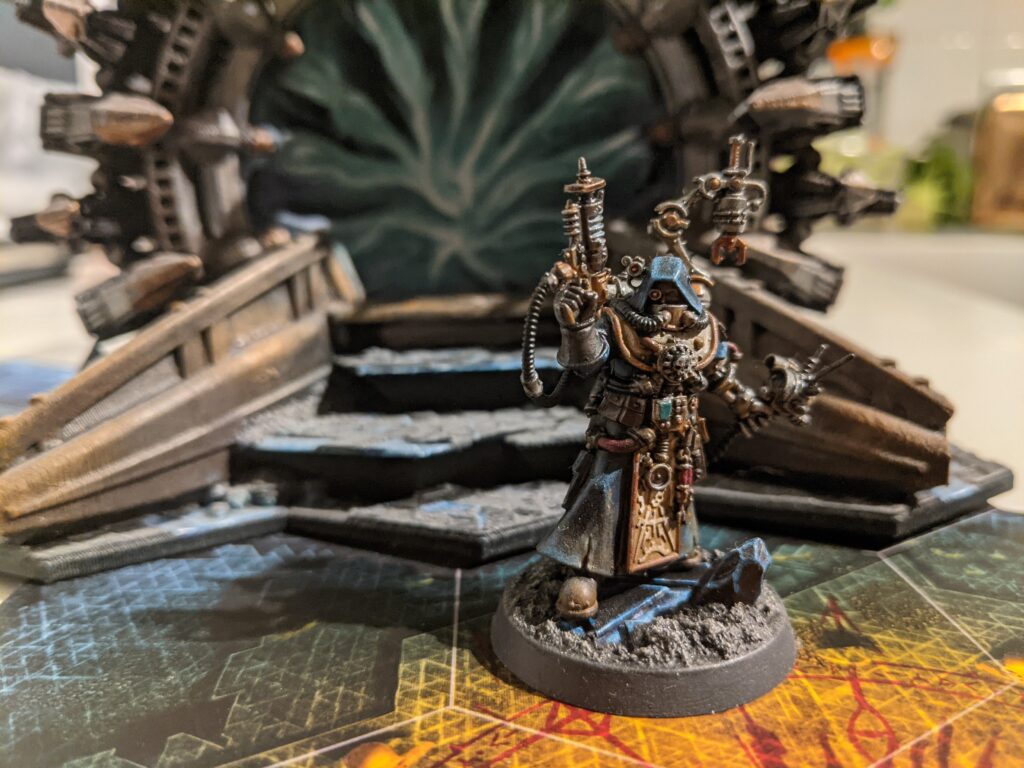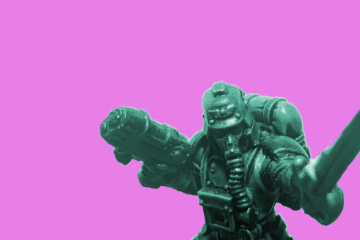With the recent announcement of Warhammer Quest: Cursed City, James looks into how Blackstone Fortress holds up since its release in 2018.
When Blackstone Fortress shines, it shines. With some of the most interesting mechanics Games Workshop have toyed with, a set of flavourful miniatures, and a table of friends, this weird, fluffy box is a charming puzzle that mixes elements from modern board games with the grim darkness of the 41st millennium.
Taken at face value, Blackstone Fortress is much like its previous incarnations. Each player chooses a hero character to dive into a dungeon of cardboard corridors and traps, meeting various challenges along the way. Mostly those challenges come from a variety of oddballs from the 40k universe, with some deep cuts to please even the most cynical of Rogue Trader era fans. Players guide their heroes through the level, killing, looting, occasionally dying, to make it through to the next stage.
Now, let’s just rewind a little to plop Blackstone in a bit of context for me. I never played the original Warhammer Quest, despite lusting after its big, strange box with a very angry man on the front back in the 90’s. I also missed Silver Tower and Shadows over Hammerhal a few years back due to not being into the hobby back then. So when Blackstone was announced in 2018, the first thing that grabbed me were the miniatures.
Oh, those miniatures! Vaping, swashbuckling space rogue? Check. The final turn on the catwalk Eldar (Aeldari, sorry) ranger? Check. Early 1920’s robot with a chaingun? Yes please. Gosh, that’s just the heroes! Then there are the Ur-Ghul, Spindle Drones, Chaos Space Marines (at the time these were the first of the ‘new’ style of chaos marines we’d seen). These models on their own meant the £80 price tag was easy enough for me to swallow. But there was also the promise of a campaign that really tickled my fancy.
Ongoing quest games have been around forever now. The mix of tabletop RPG with board games is a rich promise of easy, epic adventures, without the need for one of those pesky GMs. Blackstone fits neatly in, straddling aspects of dungeon crawling, and the tease of the legacy game as characters gather trinkets from their adventures, new enemies approach and finally, the sealed envelope only opened once the game is truly beaten.
And so, with models assembled, plentiful boards punched out, and the myriad of cards, tokens, and gubbins sorted. It was time to learn how to actually play the game.
Getting started
First up is the setup. I’m used to Warhammer 40,000 and its, let’s say, sizable amount of paperwork. Blackstone on the other hand is actually quite concise. Two of the four books the game is packed with are not needed to get going. One in fact isn’t used in the game at all and simply provides 40k rules for the included models A pleasant ‘Read this first’ signals where you should begin.
Following the guide, everything was quickly laid out on the floor. The game itself takes up a good sized dinner table (I’d hoped it’d take up a bit less space, being sans tables in my flat, but alas). It doesn’t have the compact charm of Kill Team or the recent Warcry, or even those nice small Necromunda skirmishes. Once the game is present and correct (a quick setup takes about 10-15 minutes once you are used to it.. more on that later..) your quest can begin. The game supports up to five players. One unique thing that gives an interesting balance to the proceedings is that there are always four characters. Five player games allow one person to directly control the enemies, however anywhere between one and four players, either with a character each, or sharing the reins with each other. In my campaign there are three of us, so the fourth character is almost a shared resource.
Keep goin’ through phases
It’s worth breaking down the ‘phases’ of the Blackstone Fortress campaign.
The first is the ‘meta’ campaign. Each dive into the game is an expedition, each expedition will end with you returning to home town of sorts, Precipice, with clues and technology to trade, and adding a new card to your quest deck. These cards add new twists and enemies, as well as acting as a timer of sorts for the campaign. Run out of cards before finishing the quest and its game over for everyone.
Expeditions make up the bulk of the game. An expedition normally takes four Combat cards and four Challenge cards from the expedition deck, which are then shuffled, and the top card drawn. A Combat card is a map layout, built of the games tiles, with locations of enemy groups and other traps marked. You lay out the ‘level’, and your goal is then to complete the combat scenario.
The Challenge cards are flavourful events where, well, something happens. Some Challenges are ambushes, others describe your adventurers squabbling over prized technology. There are even a few dexterity challenges thrown in. After resolving a Combat card or Challenge, you can choose to bail back to town with your loot, or press on to the next stage. This flow gives each expedition a push-your-luck edge, and one bad Challenge or Combat could leave your heroes beaten and bloodied for the rest of their expedition. Complete all eight cards and you head back to Precipice, hopefully ready to spend, lick your wounds and prepare for the next dive.
Pack your bags
Each expedition took my group around two to four hours to finish. We never bailed early, because I kept getting rules wrong, but also, those first few leaps into the unknown were a delight. The combat cards make up the bulk of the adventure and each one presents a semi-random encounter with any number of foes and these are truly the vegan protein substitute of the game.
All the peril, tension, relief, triumph comes from this section, almost to the point where everything else pales in comparison. The masterstroke is that the game is always balanced around having four heroes, regardless of the number of players. The enemies you’ll face are randomly drawn from a deck, and as you complete expeditions you will add to this stack, so you’ll go from facing hordes of easy to kill minions to hulking power armoured post-humans as your adventures continue.
Turn order for combat is defined by shuffling the initiative deck, and the order in which the cards are drawn defines the order of action. You could get three heroes making their actions before any enemy takes a step, or the traitor guard could have the jump on everyone. It feels a little like an analogue version of Final Fantasy X’s combat. The masterstroke that is each character can attempt to nudge themselves around the order. By risking a precious dice, you can try and leap ahead in the initiative order or swap yourself with one of your fellow explorers. This poses a great puzzle right at the start of the turn.
“If I can just squeeze ahead of the beastmen, I’ll take one out, then you can hopefully lay down fire?”
The next joy comes from simply figuring out what you can do on your hero’s turn. Heroes each have three to four dice that you roll at the beginning of the turn. These define what actions you can take. Obviously the higher the number the better action you can perform.

Moving uses a dice, healing uses a dice, searching uses a dice… this is a Games Workshop game, dice do stuff. Your character will have a few special moves too. Out of the eight characters (nine if you consider Rein and Raus, the ratlings, to be seperate…), my group chose a fairly balanced team. I played as the Aeldari ranger, Ammalyn Shadowguide, while my comrades chose UR-25, the big robot who knows what’s up, and the ratling twins. Our wildcard character was Pious Vorne, the very angry bald lady with a flamethrower-chainsaw combo that just screams ‘come at me heretics’. Some of the special abilities include phasing through walls or using grappling hooks, others just involve a whole lot of firepower (or just fire). The “phase through walls” skill in particular created some great moments early on where the Aeldari popped into a room of drooling, dangerous Ur-Ghul, raided the loot, and teleported back out past a number of traps, completely unscathed.
Enemies come thick and fast. Another great feature is the rudimentary AI table that can be cross-referenced with the situation. Rolling the D20 (aka the ‘blackstone dice’) will define what each enemy does on its turn. This usually results in some very aggressive opponents, leaping into your heroes’ line of sight, rushing to close the distance between you. It is sometimes a little hard to tell what actually an enemy will do, cross referencing what an enemy can see on the table, if they are in cover or not, with what you have rolled usually requires a double take. If in doubt, we normally went with the most violent path possible. It is Warhammer after all…
Murder by numbers
Kill everything in the level? Roll badly and they’ll be back. Reinforcements will be pouring through portals dotted around the stage. Worse, this can happen the instant you kill one of a group, meaning you can quickly end up with fourteen traitor guardsmen breathing down your collective necks.
It can get brutal. A few unlucky rolls and what seemed fairly tame enemies will quickly take a character out of action. Each wound takes a precious dice away meaning you can go from an effective fighting force to limping desperately to the exit in one bad turn. This does amount to a fairly swingy game session, it’s certainly enough to keep you on your toes, but it is also possible to lose your whole party in one fell swoop. While we never ran into this issue, there were a few occasions where the game felt more than just mean. This was slightly alleviated in later sessions by having bought new equipment and getting several upgrades that could get us out of tight spots.
Another issue that we quickly ran into was forever missing when we were in cover, or if enemies could see us. The art on the tiles is great, full of flavour and the odd skull, but readable in the middle of a game it is not. The thin white bar that signifies cover was often missed. Cover essentially takes a critical, unhealable wound down to a mere scratch, so these moments proved frustrating when misread. A few sessions in, I invested in a set of third party 3d printed terrain that sits on top of the board. This added more time to setup, but we quickly enjoyed a more readable tabletop.
Woes of the meta
As we dived further over multiple sessions we finally unlocked the strongholds. Each stronghold is a set of expedition cards, followed by a specific mission laid out in the Precipice booklet. Finish all four and you can attempt the final mission. At the time of writing we’ve conquered three, and were all set to jump into the final stage before we go all in on the raid on the vault. Then 2020 happened.
The challenges the strongholds put up are tough. Portals are placed so enemies are pouring directly into your characters, and you’ll come up against tough foes who quickly drain your dice and, worse, your patience.
For all its neat tricks, and those early games of Blackstone Fortress can be a delight, but after a while a malaise sets in. The new exciting items dry up, the same cards come out of the deck and no new enemies appear. Sessions quickly start to feel artificially long, and at its lowest moments, plain frustrating to finish.

It’s an easy game to fall for. The mechanics are full of crunch, the models are some of the best Games Workshop has put out in recent years, certainly the most characterful in the 41st millennium. Yet, as the sessions start to drag, it’s clear the game is front-loaded with treats, and can’t quite maintain its early thrills. There is still the joy of well-executed plans falling into place. Manipulating the turn order to pull off a well-timed heist is a joy, yet the legacy aspects mean those rewards for completing each expedition just don’t feel enough.
Of course, this could be down to how the game turned out for my group, there is a lot of randomness at play. A few times I had to step in and act as GM in more brutal situations (our first legacy card drawn would have meant the games final ‘boss’ would have been stalking us forever more… we chose to re-draw), we also never (yet) have lost a character, meaning we’ve never needed to grab rules for others. A few sessions ago I added in some additional cards Games Workshop released, to add a bit of extra flavour, which certainly alleviated a few issues. It feels sad to say, but Blackstone Fortress has a huge wealth of content that is ultimately quite samey.
Roll your own
My suggestion to would be explorers is to use it more as a grab bag, and guide the experience more for your group. Add the new enemies into your main quest as you approach the end, drop new cards into the decks so you can grab new items. Remember to swap characters a few times. We started making expeditions shorter. Eight cards with four combat situations is a bit much. While you can run away back home at any time, why not draw a shorter run of six cards? Ultimately this is your (and your group’s game). I also started fully removing encounters we had done before to prevent that feeling of ‘have we done this before?’. The expansions do help add more variety, and don’t have to be played as presented.
Blackstone Fortress does an admirable job of presenting challenges, it has a very video game rhythm when everything clicks, but as a table top experience, these systems can be revealed as quite simplistic after a time. It’s a shame, but isn’t that the way with many legacy games? Without a hook, or a midway twist that isn’t just ‘add more cards’, the expectation of simply plunging ever onwards might just be too much for some players.

Talking to my group about adding the Escalation box (again, before 2020 happened), it was telling that one friend totally dismissed it. After we finish the main quest, there is no way we’d want to start anew. Me? I still bought it, my Adeptus Mechanicus army demanded a new Tech Priest… but I have to agree, we want to move onto something else with a bit more surprise.
As a Games Workshop game set in the 40k universe, an added bonus is every included miniature included in the box and expansions have Warhammer 40,000 datasheets, allowing you to include the heroes and villains in your army. Some even have official Kill Team rules. This is a great little bonus, and can add an additional narrative layer to your more traditional skirmishes. Don’t expect them to be a meta-shifting inclusion, but a few have neat tricks, Tech Priest Daedelous in particular can be a deadly addition to an Ad Mech force.
The last vault
So there you have it. For a few sessions, Blackstone Fortress is a great game. One of the most interesting curios that Games Workshop has put out in recent years. I’d gladly introduce more people to its charms, but I would be more inclined to lean on it as a one-off or short quest experience. Out there in tabletop land there is also stiff competition making plays for your groups time, Gloomhaven being the current top of the legacy dungeon-crawl pile.
With the upcoming release of Cursed City in the next few months, it might be that the copies of Blackstone Fortress begin to dry up, and I would speculate it will be leaving shelves to make room for the new undead hotness. It is telling the expansion packs have now nearly all sold out and been removed from the official store with only the ‘final chapter’ coming out just before Christmas. This is a shame, while the expansions sometimes had an eye watering price, the opportunity to own a plastic Zoat or Ambull has already slipped away.
The game saw a good amount of support over its three year life, and has some incredible, characterful, miniatures. It is not a perfect game by a long shot, but its unique look at the 40k universe makes it a treat for people wanting to explore the lore, and a good enough experience for more tabletop gamers.
Just don’t jump in too deep.



